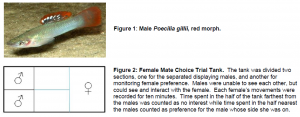Michael McEntire and Dr. Jerald Johnson, Department of Biology
Research Summary
Female mate choice (intersexual selection) and male dominance interactions (intrasexual selection) can each play important roles in sexual selection. These two mechanisms tend to be discussed in isolation. The goal of this study is to explore the interaction between these two forms of sexual selection. To test this idea, we focused on the livebearing tropical fish system Poecilia gillii (See Figure 1). We grouped males into similarly sized pairs and observed them for a week to determine which male was dominant. These pairs were then presented to females in mate choice trials to ascertain female preference. Our data appears to indicate that females prefer dominant males but we are still in the analysis stage. To determine the physical differences between dominant and submissive males, we are now analyzing the males for morphology and coloration. Female preference for dominant males also appears to be accompanied by the evolution of darker fin coloration and fuller bodies in these individuals. Because our initial data appears to support female preference for dominant males with these characters, mate choice and intrasexual competition are being shown to be working synergistically to enhance the evolution of sexual traits. We hope these initial findings will be confirmed as we finish collecting and analyzing the data.
The Research Process
My project underwent several transformations from the time I wrote my ORCA proposal. Initially, I was focused on the effects of color in this species. The effects of color in most livebearing fish are rather well studied however. After further consideration, Dr. Johnson and I decided to switch the focus of the study to the effect of male dominance on female mate choice. The interaction between the two forms of sexual selection is not very well understood. With this decision, my question became more important.
The effect of color still plays an important role in my study however. After I finished conducting the dominance and mate choice trials, I began photographing each of the males to analyze their body shape and color. Combining morphological data with color data provides a stronger argument for the synergistic evolution caused by both modes of sexual selection.
I encountered several difficulties during the research process. The most important of these were the problems the software team faced in designing anyFish. The program is still being designed and will hopefully be ready for use within a few months. My plans to use the program never came to fruition and I had to make additional plans.
I discovered another program called Object Tracker that was designed for use in analyzing fruit fly movement. After making a few modifications, we were able to use the program for tracking fish movement to allow us to analyze female body position in a mate choice tank giving us a significantly more efficient way to collect mate choice data.
Another difficulty was found in determining a way to counter the effect the male dominance trials would have on the behavior of the male fish during the mate choice trials. We altered our tank design to ensure that males wouldn’t be able to see each other (see Figure 1). Subordinate males would not be discouraged by the presence of the dominant male and therefore prevented from displaying for the female. These way females could choose between equally motivated males.
Future Plans
I am currently in the process of collecting the morphological and color data and analyzing the dominance and mate choice trial data. Analyses of all data should be finished within a few weeks.
Findings will initially be presented to the Honors Department as an Honors Thesis. I am also waiting to be accepted to present at the NCUR meetings in Ogden and also plan to present at the Evolution meetings that are to be held here in Utah in June. I also plan to submit my work to either of the journals Animal Behavior or Behavioral Ecology depending on my final results.
Acknowledgements
I am indebted to Dr. Jerald Johnson and Spencer Ingley for their mentorship and kindness during my first full research experience. Gratitude is also due to Dr. Erika Price for her guidance in the writing of my Honors Thesis.

